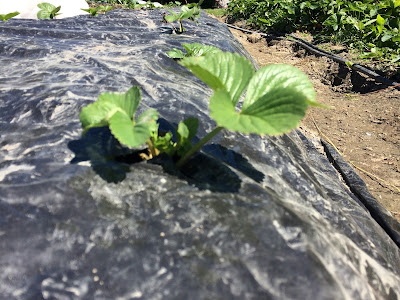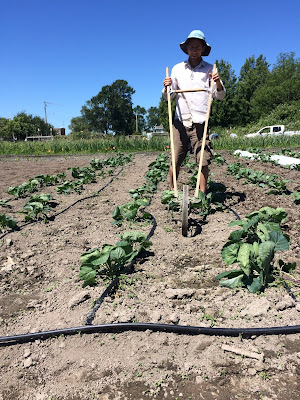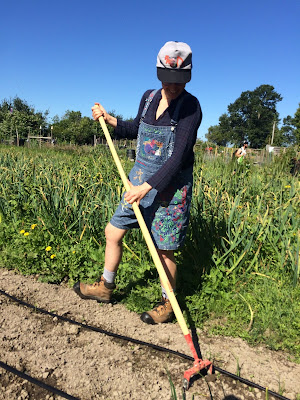 Their are often more tasks at the orchard then could possibly be completed and today (June 20) was no different. We typically perform a "walk around" discussing current progress of the crops, potential pest issues, some unique characteristics of the orchard, etc. Today, however, the tasks were delved out and with a quick huddle by the picnic tables we were ready to begin the day of work. We split ourselves up with students working on strawberry harvest, weeding the garlic crop, weeding the brassica crop, and individual students had research projects to work on.
Their are often more tasks at the orchard then could possibly be completed and today (June 20) was no different. We typically perform a "walk around" discussing current progress of the crops, potential pest issues, some unique characteristics of the orchard, etc. Today, however, the tasks were delved out and with a quick huddle by the picnic tables we were ready to begin the day of work. We split ourselves up with students working on strawberry harvest, weeding the garlic crop, weeding the brassica crop, and individual students had research projects to work on.The orchard serves as both a productive farm but also a valuable space to conduct agricultural research. A strawberry variety trial was currently taking place and students were tasked with collecting and documenting data. Working on this project has taught many of us the importance of organization and communication when carrying out a research project. Strawberries are harvested twice weekly and a count and weight is documented. If we do not correctly label and organize the varieties it is difficult to then gather accurate information. Many of us found it challenging to not sample the strawberries as we picked!
The strawberry varieties all possess unique characteristics. The flavour, size, and shape is greatly variable and may come as a surprise to the average consumer purchasing strawberries from a common grocer. The complexity of flavour is unbelievable and it was immensely satisfying to try one (or many more!) from each variety and discuss with fellow class mates.
Stark is also growing strawberries for his research project. He has an interest in season extension and developed an experiment to explore just that. There are many different strategies a farmer may use for an early start on a crop or to extend a crop later into the season. Stark is testing both floating row cover and hoop houses. He could be found that Thursday caring for this young strawberry plants.
It is so important in this course to take a moment and observe your surroundings. I took a quick walk through the orchard to see the progress of the pears. They were coming along well. There is something inexplicably special about watching a plant grow and produce fruit. It tends to take me by surprise!
 You will typically find Will at some point weeding or tending to the orchard floor on Thursdays, and today was no different. It does appear the non living mulch (wood chips) has had some success with weed suppression and may have some value in orchard floor management.
You will typically find Will at some point weeding or tending to the orchard floor on Thursdays, and today was no different. It does appear the non living mulch (wood chips) has had some success with weed suppression and may have some value in orchard floor management.Next was a check in with the brassica crop. The class had planted cauliflower, cabbage, and Brussel sprout transplants earlier in June. It is essential during this period of the plants life cycle to have little competition with weed species. A plant uses nutrients obtained from the soil to grow, weeds are often able to outcompete these young transplants. Thus weed management! And lots of it. I think each and every student would answer weeding as a task most commonly completed. And as stated for good reason. Eric was using a helpful tool, the wheel hoe. It is manually pushed through the soil and essentially severs a plants roots and shoots with a blade positioned behind the wheel. There are many different designs and models but ultimately they all have similar outcomes, terminating weed plants by a cutting action.
Mike was monitoring the plants for pest damage. Quickly the culprit of the bullet hole feeding damage was found, the flea beetle. Aptly named for its ability to hop. Flea beetles (and flea beetle larvae) may damage a crop by feeding but are more of a concern as a vector of viruses. Thus an immediate decision was made to manage the flea beetles with the intention of reducing or eliminating damage to the crop and reducing the insects population. The ecological pest management course Mike teaches has been so helpful in applying to on farm scenarios. Because the orchard follows organic standards a physical management practice would likely be the most effective in managing the flea beetle. Row covers are a quick method to control some insect pest species. They create a barrier inhibiting insects from establishing on a plant because they are simply prevented by a thin breathable fabric covering the plant. In some cases row covers can result in greater damage as you essentially trap the pest species with an ample food source. This was not a serious concern in this case.
A look at the garlic crop. Again another experiment was being conducted. Garlic is not grown like most plants. Instead of planting a seed it is much easier to plant an actual bulb of garlic. The faculty had noticed a substantial price difference between large and small red Russian garlic bulbs. And as agricultural scientists this price difference was put to the test, to determine whether it was warranted. Additionally the garlic was to be planted as both a monoculture and a polyculture with a wheat variety. Unfortunately the wheat had not established, this was attributed to the wet characteristics of the site. Instead weeds had established and the class was tasked with eliminating them. While a hoe may be useful with transplants it is unfortunately not always an appropriate tool. In this case good old hands were the best tool for the job. The students are just as effective, the first picture is the garlic crop pre weeding and below is post weeding. Pretty amazing!
And finally Nic's research project is also being conducted at the orchard! Piper can be seen here using a different hoe design to manage weeds. Nic is growing onions and carrots as both monocultures and polycultures to determine the efficacy of polycultures on control of carrot rust fly and onion maggot. Small transplants need relatively constant care to ensure successful emergence and growth. Weed management is crucial to ensure this.
The orchard is place of learning through practical farm work but also by conducting and observing the many research experiments taking place there. Sustainable agriculture is such an exciting field as many new techniques are melded with tried and true methods resulting in overall more socially and environmentally responsible systems.







































